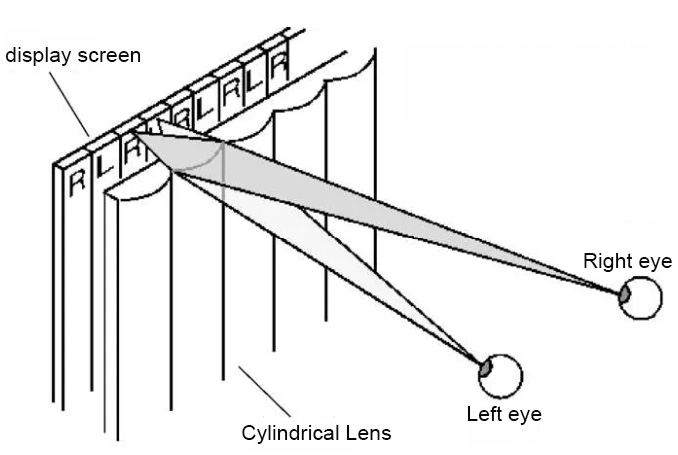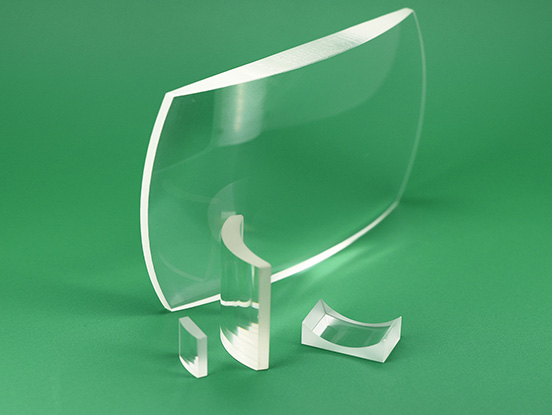Cylindrical Lens Lenticular 3D Display Technology
Nov. 28, 2023
Cylindrical lens grating 3D display technology
The optical elements underlying a column lens grating 3D display include a micro-column lens grating and a microlens array. Since most 3D display situations only require the presentation of a horizontal parallax image, only columnar lenses need to be used. The use of longitudinal strips of columnar lens grating technology results in a severe decrease in horizontal resolution, which prevents the number of viewpoints from increasing further. The use of tilted grating technology allows the horizontal resolution of the 3D image to be as close as possible to the vertical resolution.
Cylindrical Lens Lenticular 3D Display Principle
Cylindrical lens grating 3D display technology utilizes the refraction of light by the cylindrical lens grating plate to project the parallax images on the display screen in the horizontal direction to the respective corresponding viewing areas, so that the viewer's left and right eyes can see the different parallax images respectively, thus forming stereoscopic vision.
1. Cylindrical Lens Grating 3D Display System
A cylindrical lens grating 3D display system is a cylindrical lens grating plate laminated above the display so that the image plane of the display is located in the focal plane of the cylindrical lens. The display pixels are located near the focal plane of the grating and pass through the grating to form a magnified image. Inside the focal plane is a magnified virtual image, outside the focal plane is a magnified inverted real image.
As shown in the FIG., a column of pixels corresponding to a parallax image L of the left eye is arranged at intervals on a display to form a view partition underneath no cylindrical lens units of a cylindrical lens grating 3D display. A semi-cylindrical lens having a certain curvature and refractive index concentrates and projects light emitted from each pixel in a different direction, and refracts the parallax image of the left eye of the left pixel and sends it to the left eye, and refracts the parallax image of the right eye of the right pixel and sends it to the right eye, to form a 3D vision.

The biggest advantage of a cylindrical lens lenticular 3D display is that brightness is not affected. However, the black matrix between display pixels is magnified and imaged through the cylindrical lens, resulting in uncomfortable black blind intervals between clear images that appear when the viewer moves horizontally. One countermeasure is to make the display surface not exactly coincide with the focal point imaged by the cylindrical lens, thereby defocusing the black areas.
2. Optical principle of cylindrical lens unit
The cylindrical lens grating plate has cylindrical lens units that do not converge in the vertical direction parallel to the cylindrical axis and converge in the horizontal direction perpendicular to the cylindrical axis, i.e., each half-cylindrical lens unit is equivalent to a converging lens. The main parameters of a single cylindrical lens unit include the thickness d, the radius of curvature R, the pitch P, and the refractive index n.
3. Design techniques for cylindrical lens gratings
The imaging effect of the columnar lens grating technique is related to the parameters of the columnar lens. The parameters of the cylindrical lens are divided into macro and micro parameters, the macro parameters include the line number (LPI value), viewing distance D, and viewing angle range φ of the cylindrical lens grating plate; the micro parameters include the lens pitch P of the cylindrical lens grating plate, the focal length f, the radius of curvature R, the thickness d, and the refractive index n. Among them, the focal length f of the object side can be determined from the radius of curvature R and the refractive index n of the material. The refractive index n is determined by the material, and it is the known parameter. Therefore, the design of a cylindrical lens is the design of its radius of curvature, lens pitch P, and thickness d, so that it matches the specific planar display, thus obtaining a 3D display with excellent performance of the cylindrical lens grating.
Cylindrical lens parameter design not only determines the viewing distance but also determines the size of the viewing area and the distribution of the viewing space location. Different displays have different pixel sizes and other parameters, and the design of column lens parameters is also different. For the same display if the required viewing distance, the number of viewpoints, the sense of three-dimensional depth, and other 3D display effects are different, the corresponding design of the column lens parameters are also different.
CLZ Optical Co., Ltd.is a professional manufacturer who has been manufacturing and trading optical lenses for many years, Our products are used in various fields.Main products include optical domes, optical windows, optical prisms, and the cylindrical lenses mentioned in this article. We can also provide customized services, please contact us free time if you have any needs!



















